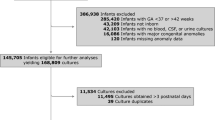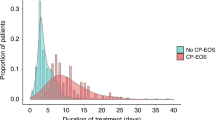Abstract
Objective
This study evaluated patterns of neonatal early onset sepsis (EOS) disease burden to guide approaches to EOS management.
Study Design
Retrospective cohort.
Result
A total of 1535 EOS cases were identified amongst 2,872,964 neonates born between 2010 and 2017 at 136 NICUs within the California Perinatal Quality Care Collaborative. EOS incidence was 7.4 per 1000 (E coli: 4.3, GBS: 1.1) in preterm, 0.76 per 1000 (E coli: 0.29, GBS: 0.22) in late preterm, and 0.31 per 1000 (E coli: 0.07, GBS 0.13) in term neonates. There was no significant change in overall incidence, though an increase in E coli (p < 0.001) and decrease in GBS (p = 0.04) incidence were noted. After adjusting for gestational age, there was no difference in the odds of death by pathogen (p > 0.2).
Conclusion
The overall EOS incidence remained steady in California NICUs from 2010–2017, though an increase in E coli and decrease in GBS EOS incidence was noted.
This is a preview of subscription content, access via your institution
Access options
Subscribe to this journal
Receive 12 print issues and online access
$259.00 per year
only $21.58 per issue
Buy this article
- Purchase on SpringerLink
- Instant access to full article PDF
Prices may be subject to local taxes which are calculated during checkout


Similar content being viewed by others

Data availability
Correspondence and request for data is available through NSJ.
References
Schrag SJ, Farley MM, Petit S, Reingold A, Weston EJ, Pondo T, et al. Epidemiology of invasive early-onset neonatal sepsis, 2005 to 2014. Pediatrics. 2016;138:e20162013–e20162013.
Verani JR, McGee L, Schrag SJ. Division of Bacterial Diseases, National Center for Immunization and Respiratory Diseases, Centers for Disease Control and Prevention (CDC). Prevention of perinatal group B streptococcal disease-revised guidelines from CDC, 2010. MMWR Recomm Rep. 2010;59:1–36.
Seedat F, Marshall J. Re: Universal screening versus risk-based protocols for antibiotic prophylaxis during childbirth to prevent early-onset group B streptococcal disease: a systematic review and meta-analysis. BJOG: Int J Obstet Gynaecol. 2020;127:1038–9.
Committee Opinion No. 712. Intrapartum management of intraamniotic infection. Obstet Gynecol. 2017;130:e95–101.
Stoll BJ, Puopolo KM, Hansen NI, Sánchez PJ, Bell EF, Carlo WA, et al. Early-onset neonatal sepsis 2015 to 2017, the rise of Escherichia coli, and the need for novel prevention strategies. JAMA Pediatr. 2020;174:e200593.
Stoll BJ, Hansen NI, Sánchez PJ, Faix RG, Poindexter BB, Meurs KPV, et al. Early onset neonatal sepsis: the burden of group B streptococcal and E. coli disease continues. Pediatrics. 2011;127:817–26.
Stoll BJ, Hansen N, Fanaroff AA, Wright LL, Carlo WA, Ehrenkranz RA, et al. Changes in pathogens causing early-onset sepsis in very-low-birth-weight infants. N Engl J Med. 2002;347:240–7.
Giannoni E, Agyeman PKA, Stocker M, Posfay-Barbe KM, Heininger U, Spycher BD, et al. Neonatal sepsis of early onset, and hospital-acquired and community-acquired late onset: a prospective population-based cohort study. J Pediatrics. 2018;201:106–114.e4.
Edwards EM, Ehret DEY, Soll RF, Horbar JD. Vermont Oxford Network: a worldwide learning community. Transl Pediatr. 2019;8:182–92.
Pai VV, Lee HC, Profit J. Improving uptake of key perinatal interventions using statewide quality collaboratives. Clin Perinatol. 2018;45:165–80.
Ely DM, Driscoll AK. Infant mortality in the United States, 2017: data from the period linked birth/infant death file. Natl Vital- Stat Rep. 2019;68:1–20.
Braun D, Bromberger P, Ho NJ, Getahun D. Low rate of perinatal sepsis in term infants of mothers with chorioamnionitis. Am J Perinatol. 2016;33:143–50.
Flannery DD, Edwards EM, Puopolo KM, Horbar JD. Early-onset sepsis among very preterm infants. Pediatrics. 2021;148:e2021052456.
Martin JA, Hamilton BE, Osterman MJK, Driscoll AK. Births: final data for 2019. Natl Vital- Stat Rep. 2021;70:1–51.
de Cueto M, Sanchez MJ, Sampedro A, Miranda JA, Herruzo AJ, Rosa-Fraile M. Timing of intrapartum ampicillin and prevention of vertical transmission of group B streptococcus. Obstet Gynecol. 1998;91:112–4.
Nanduri SA, Petit S, Smelser C, Apostol M, Alden NB, Harrison LH, et al. Epidemiology of invasive early-onset and late-onset group B streptococcal disease in the United States, 2006 to 2015: multistate laboratory and population-based surveillance. JAMA Pediatr. 2019;173:224.
Puopolo KM, Benitz WE, Zaoutis TE. AAP Committee on Fetus and Newborn, AAP Committee on fetus and newborn. management of neonates born at ≤34 6/7 weeks’ gestation with suspected or proven early-onset bacterial sepsis. Pediatrics. 2018;142:e20182896.
Puopolo KM, Benitz WE, Zaoutis TE. AAP Committee on Fetus and Newborn, AAP Committee on Infectious Disease. Management of neonates born at ≥35 0/7 weeks’ gestation with suspected or proven early-enset bacterial sepsis. Pediatrics. 2018;142:e20182894.
Puopolo KM, Draper D, Wi S, Newman TB, Zupancic J, Lieberman E, et al. Estimating the probability of neonatal early-onset infection on the basis of maternal risk factors. Pediatrics. 2011;128:e1155–1163.
Joshi NS, Gupta A, Allan JM, Cohen RS, Aby JL, Kim JL, et al. Management of chorioamnionitis-exposed infants in the newborn nursery using a clinical examination-based approach. Hosp Pediatr. 2019;9:227–33.
Joshi NS, Gupta A, Allan JM, Cohen RS, Aby JL, Weldon B, et al. Clinical monitoring of well-appearing infants born to mothers with chorioamnionitis. Pediatrics. 2018;141:e20172056.
Frymoyer A, Joshi NS, Allan JM, Cohen RS, Aby JL, Kim JL, et al. Sustainability of a clinical examination-based approach for ascertainment of early-onset sepsis in late preterm and term neonates. J Pediatrics. 2020;225:263–8.
Escobar GJ, Puopolo KM, Wi S, Turk BJ, Kuzniewicz MW, Walsh EM, et al. Stratification of risk of early-onset sepsis in newborns ≥ 34 weeks’ gestation. Pediatrics 2014;133:30–6.
Kuzniewicz MW, Puopolo KM, Fischer A, Walsh EM, Li S, Newman TB, et al. A quantitative, risk-based approach to the management of neonatal early-onset sepsis. JAMA Pediatr. 2017;171:365–71.
Dhudasia MB, Mukhopadhyay S, Puopolo KM. Implementation of the sepsis risk calculator at an academic birth hospital. Hosp Pediatr. 2018;8:243–50.
Achten NB, Dorigo-Zetsma JW, van der Linden PD, van Brakel M, Plötz FB. Sepsis calculator implementation reduces empiric antibiotics for suspected early-onset sepsis. Eur J Pediatr. 2018;177:741–6.
Achten NB, Klingenberg C, Benitz WE, Stocker M, Schlapbach LJ, Giannoni E, et al. Association of use of the neonatal early-onset sepsis calculator with reduction in antibiotic therapy and safety: a systematic review and meta-analysis. JAMA Pediatr. 2019;173:1032–40.
Benitz WE, Achten NB. Finding a role for the neonatal early-onset sepsis risk calculator. EClinicalMedicine. 2020;19:100255.
Carola D, Vasconcellos M, Sloane A, McElwee D, Edwards C, Greenspan J, et al. Utility of early-onset sepsis risk calculator for neonates born to mothers with chorioamnionitis. J Pediatrics. 2018;195:48–52.e1.
Berardi A, Fornaciari S, Rossi C, Patianna V, Bacchi Reggiani ML, Ferrari F, et al. Safety of physical examination alone for managing well-appearing neonates ≥ 35 weeks’ gestation at risk for early-onset sepsis. J Matern Fetal Neonatal Med. 2015;28:1123–7.
Berardi A, Bedetti L, Spada C, Lucaccioni L, Frymoyer A. Serial clinical observation for management of newborns at risk of early-onset sepsis. Curr Opin Pediatr. 2020;32:245–51.
Cantoni L, Ronfani L, Da Riol R, Demarini S. Perinatal Study Group of the Region Friuli-Venezia Giulia. Physical examination instead of laboratory tests for most infants born to mothers colonized with group B Streptococcus: support for the Centers for Disease Control and Prevention’s 2010 recommendations. J Pediatr. 2013;163:568–73.
Acknowledgements
The work described in this manuscript was supported by the Stanford Maternal and Child Health Research Institute. Dr. Joshi is an Ernest and Amelia Gallo Endowed Postdoctoral Fellow of the Stanford Maternal and Child Health Research Institute.
Author information
Authors and Affiliations
Contributions
All authors helped conceptualize and design study and critically interpreted data. All authors approved the final manuscript as submitted and agree to be accountable for all aspects of the work. NSJ drafted the initial manuscript with input from AF. HCL, KH, and TL critically reviewed the manuscript. KH and TL performed the statistical analyses. NSJ, HCL, and AF supervised data analysis.
Corresponding author
Ethics declarations
Competing interests
AF is a scientific consultant for Takeda Pharmaceuticals unrelated to this work. The other authors declare no conflicts of interest.
Additional information
Publisher’s note Springer Nature remains neutral with regard to jurisdictional claims in published maps and institutional affiliations.
Rights and permissions
About this article
Cite this article
Joshi, N.S., Huynh, K., Lu, T. et al. Epidemiology and trends in neonatal early onset sepsis in California, 2010–2017. J Perinatol 42, 940–946 (2022). https://doi.org/10.1038/s41372-022-01393-7
Received:
Revised:
Accepted:
Published:
Issue Date:
DOI: https://doi.org/10.1038/s41372-022-01393-7


